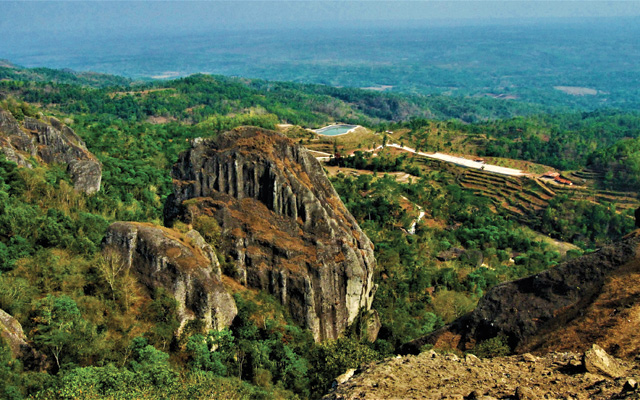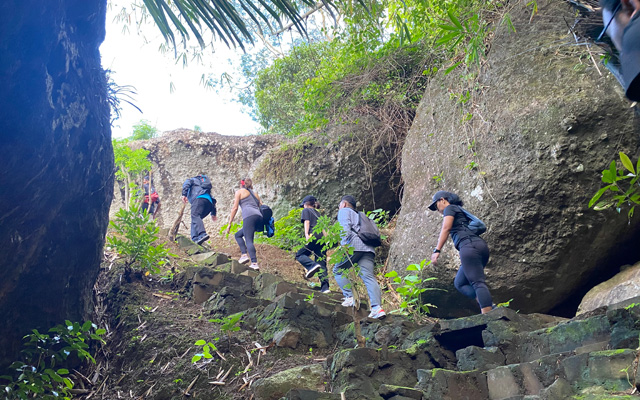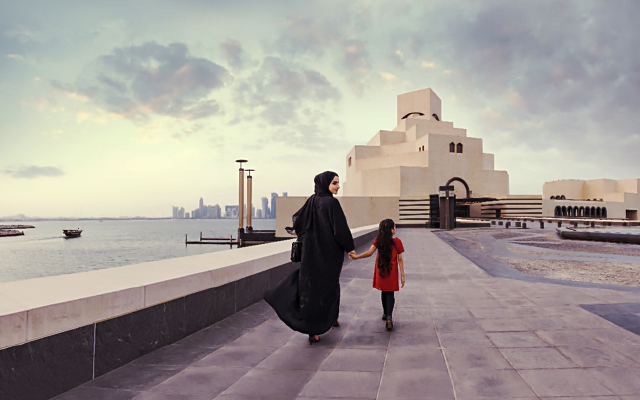Nglanggeran Eco-Village in Indonesia strives to maintain equilibrium between nature and tourism, while catering to the needs of travellers seeking to experience the best of the area.
Amid serene hills, stones, and an ancient volcano, Nglanggeran Eco-Village, one of the UN Tourism’s best tourism villages in 2021, attempts to balance tourism and conservation.
A journey to Nglanggeran ancient volcano, part of Mount Sewu UNESCO Global Geopark, means traversing a landscape that looks much as it has for centuries. At 700m above sea level, the volcano, characterised by enormous chunks of rocks and a mystic atmosphere connects its villages. Sheep graze the valley floor, family farm, and cacao groves intermingle with fields of paddies and the reservoir.

Communities in Nglanggeran have depended on the ancient volcano since before recorded history. For generations, residents have made a living by selling wood and stone mined from ancient volcanoes, leaving the area barren and dry, until a group of young people realised that this would not only destroy the beautiful nature, but also abandon its residents.
“30 years ago, all the young men ran away from the village, either as migrant workers abroad or migrated to Jakarta – the only ones left behind were the elderly or babies, including me and 15 other kids,” Sugeng Handoko, initiator and secretary of Nglanggeran’s tourism working group (Pokdarwis) told TTG Asia during a UN Tourism media trip.
“At that time, no one understood tourism. All we cared about was how to keep the water flowing, and the only way we knew (how to) was to plant trees, and we kept up reforestation activities until 1999, (when) a bunch of students came to climb the mountain.”
From groups of 10 students to thousands of people coming to see the ancient volcano, the popularity of the land formation continues to rise and was eventually named the best climbing spot in Yogyakarta. A favourite among mountain climbing fans, its climbing route is also suitable for beginners.
“We saw an opportunity, by making an entrance ticket to the ancient volcano and managing vehicle storage services for visitors. At that time, we only charged fees of 500 rupiah (US$0.03) per pax,” said Sugeng.
Since then, Sugeng and friends tried to develop tourism in Nglanggeran by marketing the ancient volcano as a place for student activities, from camping to gatherings.
However, in 2011, Pokdarwis changed its tourism strategy by selling live-in tour packages. The first guests were 120 high school juniors from Jakarta. They were invited to join the residents in their daily activities, such as farming and hunting for wood and stone on the mountain.
Aris Budiyono, who together with Sugeng initiated Nglanggeran’s tourism working group, recalled that the money made from this live-in package “was very big” and every cent went directly to the community.
“Farmers whose fields were borrowed for rice planting activities, breeders whose livestock were used for students to learn about livestock cultivation, and even stone miners received an income of 50,000 to 200,000 rupiah, quite a lot for them at that time,” said Aris.
The villages continued to bustle with student groups. Lilik Suharyanto, a treasurer of Nglanggeran’s Pokdarwis, shared that there were three to five groups of students every week, ranging from 50 to 150 pax each time.
“Because of that, we need additional workers. We have now employed people outside the five core villages that surround Nglanggeran,” said Lilik.
The growing demand for educational and adventure tourism to Nglanggeran has forced Pokdarwis to be creative with its tourism packages. Lilik said new products would be ready within two or three years, joining 13 activities that are now available. Currently, visitors can join tours of cocoa plantation and factory to learn how to grow cacao trees and transform the beans into various items; take lessons on traditional dance, such as jatilan, reog and mataram; and have opportunities to indulge in the traditional musical art of karawitan.
Nglanggeran’s growing popularity, unfortunately, ran against the villagers’ desire for nature preservation and cleanliness.
Mursidi, head of Pokdarwis, said: “We thought about closing Nglanggeran because rubbish was piling up and blocking the flow of water. Vandalism also made people so angry that they did not want to continue with tourism.”
Conservation was a top concern for residents, as it is tied to the vulnerability of people, nature and culture.
“Nglanggeran’s big picture includes the environment, economic growth, and the balance between them,” emphasised Mursidi.

To address this, Pokdarwis drew up a new tourism strategy that puts locals and conservation at the centre. One action plan calls for limited tourist visits
– no more than three groups of 200
people per group are allowed each week.
Since 2015, Nglanggeran has an e-ticketing system in place and only accepts online reservations.
This restriction benefits the mental health of residents.
Sugeng explained that the tourism story is about the local people.
“If they are unhappy, tourists won’t be happy either,” he said.
Mursidi added that it was important to “welcoming (tourists) who will value nature as a priceless asset”.
Marketing strategies have also evolved. Previously, promotions were carried out sporadically for the general public. Since 2015, Nglanggeran only targets the upper-middle class, and focuses on tour packages with local activities as the main attraction.
“We no longer simply sell entrance tickets,” Sugeng said.
The new strategy pays off. Nglanggeran’s popularity continues to soar, revenue is on the rise, and residents are happy with the high quality of visitors.
In 2014, before the new tourism strategy was in place, Nglanggeran attracted 325,303 tourists – the highest in its history – who generated 1.42 billion rupiah.
In 2022, tourism revenue hit 2.5 billion rupiah through just 77,725 visitors. In fact, Nglanggeran continued to record an average of one billion rupiah in revenue every year of the Covid pandemic (2020 and 2021).
Reflected on Nglanggeran’s accomplishment in responsible tourism development, Sugeng told TTG Asia that “tourism is not about the numbers”, but how well the host community is empowered as a result.
















